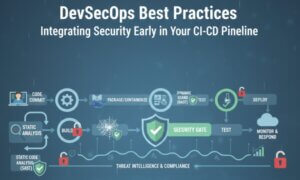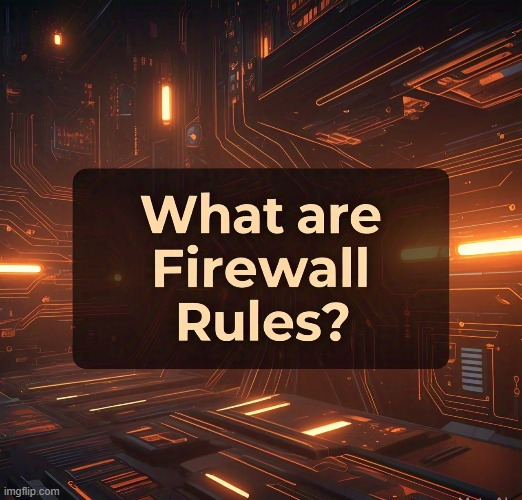Firewalls serve as the first line of defense against malicious attacks. Whether for individual users, businesses, or enterprises, firewalls play a crucial role in controlling network traffic and ensuring that only authorized connections are allowed. But how do firewalls determine what traffic to permit or block? The answer lies in firewall rules—the predefined policies that dictate how data flows in and out of a network. In this article, we will explore what firewall rules are, their importance, how they work, and best practices for configuring them effectively.
Table of Contents
What Are Firewall Rules?
Firewall rules are specific configurations set within a firewall to control incoming and outgoing network traffic based on predefined security policies. These rules determine whether data packets should be allowed, blocked, or rejected based on various attributes such as IP addresses, ports, and protocols.
Each rule operates based on a set of conditions, which may include:
Source IP Address: The IP address from which the traffic originates.
Destination IP Address: The IP address of the intended recipient.
Port Number: The specific port being used for communication (e.g., HTTP uses port 80, HTTPS uses port 443).
Protocol: The communication protocol being used, such as TCP, UDP, or ICMP.
Action: The decision to allow or block traffic based on the rule’s parameters.
Types of Firewall Rules
Firewall rules can be categorized based on their function and how they handle traffic. Below are the primary types of firewall rules:
1. Allow Rules
These rules permit traffic that meets the specified conditions. For example, a firewall rule can allow inbound traffic from a trusted IP address to a web server on port 443 (HTTPS).
2. Deny Rules
Deny rules explicitly block traffic that matches certain criteria. This is useful for preventing unauthorized access or restricting communication from known malicious IPs.
3. Default Rules
Many firewalls have default rules that apply when no other specific rules match. For instance, most firewalls have a deny all rule by default, blocking all traffic unless an explicit allow rule is configured.
4. Inbound and Outbound Rules
Inbound Rules: These govern incoming traffic to the network or device.
Outbound Rules: These control the traffic leaving the network or device.
5. Stateless vs. Stateful Rules
Stateless Rules: These evaluate each packet independently, without considering previous packets in the session.
Stateful Rules: These track active connections and make decisions based on the overall session context.
How Firewall Rules Work
Firewall rules operate based on a sequential evaluation process. When a data packet enters or exits a network, the firewall checks its attributes against the rule set. The first rule that matches the packet’s parameters dictates the action. This process follows these steps:
Packet Arrival: A data packet reaches the firewall.
Rule Matching: The firewall evaluates the packet against its rule list, starting from the top.
Action Execution: Once a match is found, the firewall executes the associated action (allow, deny, or log).
Logging (Optional): Some firewalls log rule evaluations for monitoring and auditing purposes.
Packet Forwarding or Dropping: If the packet is allowed, it continues to its destination; if denied, it is discarded.
Best Practices for Configuring Firewall Rules
To ensure a secure and efficient network, firewall rules must be configured properly. Here are some best practices:
1. Implement a Least Privilege Policy
Allow only the traffic that is necessary and block everything else by default. This minimizes the risk of unauthorized access.
2. Use Specific Rules Instead of Broad Rules
Avoid generic allow rules (e.g., allowing all traffic from any IP). Instead, define rules with specific IP ranges, ports, and protocols.
3. Regularly Review and Update Rules
Periodically audit firewall rules to remove outdated or unnecessary entries. Cyber threats evolve, and so should firewall policies.
4. Enable Logging and Monitoring
Logging firewall activity helps identify suspicious behavior, misconfigurations, and potential security breaches.
5. Restrict Administrative Access
Only authorized personnel should be allowed to modify firewall rules. Use role-based access control (RBAC) where possible.
6. Use Stateful Inspection
Stateful firewalls provide better security by tracking active connections and making context-aware decisions.
7. Apply Geo-Blocking Where Necessary
Blocking traffic from regions known for cyber threats can reduce the risk of attacks.
8. Test New Rules Before Deployment
Changes to firewall rules should be tested in a controlled environment before applying them to a live network.
Common Mistakes in Firewall Rule Configuration
While firewalls are essential for security, misconfigured rules can lead to vulnerabilities. Some common mistakes include:
Overly Permissive Rules: Allowing too much traffic can expose the network to attacks.
Rule Conflicts: Conflicting rules may cause unintended security gaps or disruptions.
Neglecting Rule Order: Since firewalls process rules sequentially, placing less restrictive rules above restrictive ones can lead to security loopholes.
Failure to Document Changes: Keeping track of rule modifications is crucial for troubleshooting and compliance.
Conclusion
Firewall rules are the backbone of network security, defining what traffic is permitted and what is blocked. Understanding how these rules work and implementing best practices can significantly enhance an organization’s cybersecurity posture. Regular audits, strict access controls, and proper logging can help maintain a secure and efficient firewall configuration. As cyber threats continue to evolve, staying proactive with firewall rule management is essential for safeguarding digital assets and maintaining a robust security framework.
References
Why Businesses Trust SecureMyOrg For Comprehensive Network Security
At SecureMyOrg, we uncover and fix all possible security vulnerabilities of mobile and web, while providing solutions to mitigate risks. We are trusted by renowned companies like Yahoo, Gojek and Rippling, and with 100% client satisfaction, you’re in safe hands!







Some of the things people reach out to us for –
- Building their cybersecurity program from scratch – setting up cloud security using cost-effective tools, SIEM for alert monitoring, building policies for the company
- Vulnerability Assessment and Penetration Testing ( VAPT ) – We have certified professionals, with certifications like OSCP, CREST – CPSA & CRT, CKA and CKS
- DevSecOps consulting
- Red Teaming activity
- Regular security audits, before product release
- Full time security engineers.
Relevant Posts

How To Inspect Encrypted Traffic Without Breaking Privacy
Network administrators face a challenge: securing systems while respecting privacy. This guide explains how to inspect encrypted traffic without breaking privacy using metadata, anomaly detection, and machine learning ensuring visibility, compliance, and trust.

How to Audit Infrastructure as Code (IaC) for Security Vulnerabilities
Discover how to audit Infrastructure as Code (IaC) for security vulnerabilities with this practical guide. Learn to scan IaC files using tools like Checkov, fix issues like exposed resources, and integrate audits into CI/CD pipelines. Protect your cloud systems from misconfigurations and ensure compliance with clear, actionable steps.

DevSecOps Best Practices: Integrating Security Early in Your CI/CD Pipeline
This article provides a practical guide to embedding security into every stage of your CI/CD pipeline. Learn core DevSecOps best practices like SAST, DAST, dependency scanning, secrets management, and compliance automation to catch vulnerabilities early, foster a culture of shared ownership, and build a secure-by-design development process that accelerates release cycles.

5 Cloud Misconfigurations That Lead to Data Breaches
Cloud misconfigurations are one of the leading causes of data breaches, yet they’re also among the most preventable. From exposed storage buckets to weak IAM policies, attackers exploit these mistakes daily. Learn about the top 5 misconfigurations and how your organization can fix them before they lead to costly data exposure.

How Can Ethical Hacking Training Elevate Your Internal Cybersecurity?
Ethical hacking training empowers organizations to strengthen internal cybersecurity by uncovering vulnerabilities before attackers do. From mastering penetration testing to enhancing incident response, this training builds a proactive security culture. Learn how Secure My ORG’s programs can elevate your team’s skills and fortify defenses against modern threats like AI-driven attacks.

AI‑Generated Malware: Threat or Hype?
AI-generated malware uses advanced algorithms to create adaptive and hard-to-detect threats, posing serious challenges for modern cybersecurity defenses. Unlike traditional malware, it can evolve on its own, learning how to bypass security systems without human input. As a result, cybersecurity teams must increasingly rely on AI-driven tools and strategies to detect and neutralize these sophisticated digital attacks.
